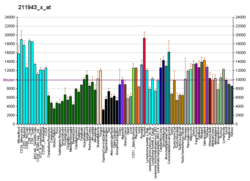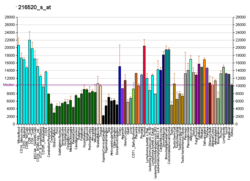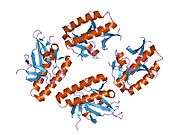Translationally-controlled tumor protein
Translationally Controlled Tumor Protein (TCTP) is a protein that in humans is encoded by the TPT1 gene.[3][4][5] The TPT1 gene is mapped 13q12-q1413 in the Chromosome 13.[4] The human gene contains five introns and six exons, The TPT1-gene contains a promoter with a canonical TATA-box and several promoter elements, which are well-conserved in mammals.[6] The assay with reporter gene exhibits a strong promoter activity comparable to viral promoters.[7]
TCTP protein is also referred to as Q23,[8] P21,[9] P23,[10] histamine releasing factor (HRF),[11] and fortilin.[12] TCTP is a multifunctional and highly conserved protein that existed ubiquitously in different eukaryote species and distributed widely in various tissues and cell types.[13]
Human translationally controlled tumor protein (hTCTP) is a growth-related, calcium-binding protein.[14]
History
Translationally controlled tumor protein was first discovered in 1989 as a cDNA sequence obtained from a human mammary carcinoma cDNA library with proves derived from the translationally controlled, growth-related mouse tumor protein TCTP.[15] TCTP was originally described as a growth related protein of tumor cells. Its mRNA accumulates in translationally repressed postpolysomal mRNP-complexes.[16]
Research in 1997 shown that TCTP is not a tumor- or tissue-specific protein, but is expressed ubiquitously from plants to mammals.[17][18][19][20]
Characteristics
TCTP is a 20–25 kDa protein abundantly and ubiquitously expressed in the cell.[14] The protein is transcribed in more than 500 different tissues and cell types; hTCTP gene is one of the top 10 most ubiquitously expressed genes in humans by examining 1753 libraries from kinds of tissues,[21] but differed considerably in their quantity and ratio of expression. The expression is lower in kidney and renal cells.[17] This indicates an extensive transcriptional control and involvement of tissue-specific factors.[6]
The majority of publications established TCTP to be a cytoplasmic protein but nuclear localisation has also been reported, as well as extracellular activity; however, the process of secretion has not been found.[6]
Function
The abundance and ubiquity indicate that TCTP may have important primary functions. However, a large number of cellular and biochemical functions have been found since 1980s. Most of these functions can be classified into three groups.[14]
Growth-related
TCTP has properties of a tubulin binding protein that associates with microtubules in a cell cycle-dependent manner.[22][23]
The transient overexpression of TCTP in HeLa cells prevented them from undergoing etoposide-induced apoptosis.[12] Expressing TCTP in U2OS (human bone osteosarcoma epithelial cells) protected them from cell death induced by etoposide over various concentrations and durations of exposure.[12] TCTP overexpression inhibited caspase-3-like activity as assessed by the cleavage of fluorogenic substrate.[12]
Expression levels of TCTP were down-regulated at the mRNA and protein levels during tumor suppression and by the activation of p53 and Siah-1 very well known anti-tumor genes.[24][25] Down-regulation of TCTP can induce tumor reversion, and in combination with some drugs that decrease the level of TCTP and will lead to kill tumor cells.[26] TCTP knockdown in primary mammary tumor cells, results in increased p53 expression and a decreased number of stem-like cancer cells.[27]
Reducing TCTP (dTCTP) levels in Drosophila reduces cell size, cell number and organ size, which mimics Drosophila Rheb (dRheb) mutant phenotypes; human TCTP (hTCTP) shows similar biochemical properties compared to dTCTP.
Immunity-related
TCTP caused histamine release from the human basophils of a subpopulation of donors, and this release was dependent on IgE.[11][28] The expression of TCTP is regulated at two distinct levels, depletion of the ER calcium causes an increase in TCTP mRNA abundance, increased cytosolic calcium concentrations regulate gene expression at the post-transcriptional level.[17][29][30]
Downregulation of the protein levels by siRNA in HTR-8/SVneo (Homo sapiens placenta cells) was associated with a reduced cellular calcium-uptake activity and buffering capacity.[6]
Cancer-related
Translationally-controlled tumor protein has a role in tumor reversion and development.[31][32]
Translationally Controlled Tumor Protein (TCTP/tpt1) is a regulator of the cancer stem cell compartment,[33] the tumor reversion,[34][35] tumor progression and certain forms of inflammatory diseases.[11] Moreover, TCTP was described as a pro-survival protein antagonizing BAX function.[36]
Structure
Sequence alignment of TCTP sequences from more than 30 different species reveals a high degree of conservation over a long period of evolution.[6]
The solution structure of TCTP from yeast, Schizosaccharomyces pombe has been determined by NMR spectroscopy which indicated that this protein is structurally similar to two small guanine nucleotide-free chaperones, namely Mss4 and Dss4.[37] TCTP and Mss4/Dss4 are now therefore structurally grouped into one protein superfamily.[6]
Translationally Controlled Tumor Protein (TCTP) is involved in a wide range of molecular interactions with biological and nonbiological partners of various chemical compositions such as proteins, peptides, nucleic acids, carbohydrates, or small molecules. TCTP is therefore an important and versatile binding platform. Many of these protein–protein interactions have been validated, albeit only few received an in-depth structural characterization. In TCTP/tpt1 - Remodeling Signaling from Stem Cell to Disease, focus is on the structural analysis of TCTP and the review of the available literature regarding its interaction network from a structural perspective. [38]
Interactions
TCTP has been shown to interact with:
References
- "Human PubMed Reference:". National Center for Biotechnology Information, U.S. National Library of Medicine.
- "Mouse PubMed Reference:". National Center for Biotechnology Information, U.S. National Library of Medicine.
- Gross B, Gaestel M, Böhm H, Bielka H (October 1989). "cDNA sequence coding for a translationally controlled human tumor protein". Nucleic Acids Research. 17 (20): 8367. doi:10.1093/nar/17.20.8367. PMC 334973. PMID 2813067.
- MacDonald SM, Paznekas WA, Jabs EW (Jun 1999). "Chromosomal localization of tumor protein, translationally-controlled 1 (TPT1) encoding the human histamine releasing factor (HRF) to 13q12-->q14". Cytogenetics and Cell Genetics. 84 (1–2): 128–9. doi:10.1159/000015238. PMID 10343127.
- "Entrez Gene: TPT1 tumor protein, translationally-controlled 1".
- Bommer UA, Thiele BJ (March 2004). "The translationally controlled tumour protein (TCTP)". The International Journal of Biochemistry & Cell Biology. 36 (3): 379–85. doi:10.1016/S1357-2725(03)00213-9. PMID 14687915.
- Thiele H, Berger M, Lenzner C, Kühn H, Thiele BJ (October 1998). "Structure of the promoter and complete sequence of the gene coding for the rabbit translationally controlled tumor protein (TCTP) P23". European Journal of Biochemistry / FEBS. 257 (1): 62–8. doi:10.1046/j.1432-1327.1998.2570062.x. PMID 9799103.
- Thomas G, Thomas G, Luther H (September 1981). "Transcriptional and translational control of cytoplasmic proteins after serum stimulation of quiescent Swiss 3T3 cells". Proceedings of the National Academy of Sciences of the United States of America. 78 (9): 5712–6. doi:10.1073/pnas.78.9.5712. PMC 348838. PMID 6946510.
- Yenofsky R, Bergmann I, Brawerman G (October 1982). "Messenger RNA species partially in a repressed state in mouse sarcoma ascites cells". Proceedings of the National Academy of Sciences of the United States of America. 79 (19): 5876–80. doi:10.1073/pnas.79.19.5876. PMC 347013. PMID 6964392.
- Böhm H, Benndorf R, Gaestel M, Gross B, Nürnberg P, Kraft R, Otto A, Bielka H (August 1989). "The growth-related protein P23 of the Ehrlich ascites tumor: translational control, cloning and primary structure". Biochemistry International. 19 (2): 277–86. PMID 2479380.
- MacDonald SM, Rafnar T, Langdon J, Lichtenstein LM (August 1995). "Molecular identification of an IgE-dependent histamine-releasing factor". Science. 269 (5224): 688–90. doi:10.1126/science.7542803. PMID 7542803.
- Li F, Zhang D, Fujise K (December 2001). "Characterization of fortilin, a novel antiapoptotic protein". The Journal of Biological Chemistry. 276 (50): 47542–9. doi:10.1074/jbc.M108954200. PMID 11598139.
- Ren C, Chen T, Jiang X, Wang Y, Hu C (December 2014). "The first characterization of gene structure and biological function for echinoderm translationally controlled tumor protein (TCTP)". Fish & Shellfish Immunology. 41 (2): 137–46. doi:10.1016/j.fsi.2014.08.030. PMID 25193395.
- Feng Y, Liu D, Yao H, Wang J (November 2007). "Solution structure and mapping of a very weak calcium-binding site of human translationally controlled tumor protein by NMR". Archives of Biochemistry and Biophysics. 467 (1): 48–57. doi:10.1016/j.abb.2007.08.021. PMID 17897616.
- Gross B, Gaestel M, Böhm H, Bielka H (October 1989). "cDNA sequence coding for a translationally controlled human tumor protein". Nucleic Acids Research. 17 (20): 8367. doi:10.1093/nar/17.20.8367. PMC 334973. PMID 2813067.
- Chitpatima ST, Makrides S, Bandyopadhyay R, Brawerman G (March 1988). "Nucleotide sequence of a major messenger RNA for a 21 kilodalton polypeptide that is under translational control in mouse tumor cells". Nucleic Acids Research. 16 (5): 2350. doi:10.1093/nar/16.5.2350. PMC 338237. PMID 3357792.
- Sanchez JC, Schaller D, Ravier F, Golaz O, Jaccoud S, Belet M, Wilkins MR, James R, Deshusses J, Hochstrasser D (January 1997). "Translationally controlled tumor protein: a protein identified in several nontumoral cells including erythrocytes". Electrophoresis. 18 (1): 150–5. doi:10.1002/elps.1150180127. PMID 9059837.
- Bhisutthibhan J, Pan XQ, Hossler PA, Walker DJ, Yowell CA, Carlton J, Dame JB, Meshnick SR (June 1998). "The Plasmodium falciparum translationally controlled tumor protein homolog and its reaction with the antimalarial drug artemisinin". The Journal of Biological Chemistry. 273 (26): 16192–8. doi:10.1074/jbc.273.26.16192. PMID 9632675.
- Yan L, Fei K, Bridge D, Sarras MP (October 2000). "A cnidarian homologue of translationally controlled tumor protein (P23/TCTP)". Development Genes and Evolution. 210 (10): 507–11. doi:10.1007/s004270000088. PMID 11180799.
- Sage-Ono K, Ono M, Harada H, Kamada H (March 1998). "Dark-induced accumulation of mRNA for a homolog of translationally controlled tumor protein (TCTP) in Pharbitis". Plant & Cell Physiology. 39 (3): 357–60. doi:10.1093/oxfordjournals.pcp.a029377. PMID 9588028.
- Thompson HG, Harris JW, Wold BJ, Quake SR, Brody JP (October 2002). "Identification and confirmation of a module of coexpressed genes". Genome Research. 12 (10): 1517–22. doi:10.1101/gr.418402. PMC 187523. PMID 12368243.
- Gachet Y, Tournier S, Lee M, Lazaris-Karatzas A, Poulton T, Bommer UA (April 1999). "The growth-related, translationally controlled protein P23 has properties of a tubulin binding protein and associates transiently with microtubules during the cell cycle". Journal of Cell Science. 112 (8): 1257–71. PMID 10085260.
- Yarm FR (September 2002). "Plk phosphorylation regulates the microtubule-stabilizing protein TCTP". Molecular and Cellular Biology. 22 (17): 6209–21. doi:10.1128/MCB.22.17.6209-6221.2002. PMC 134017. PMID 12167714.
- Cans C, Passer BJ, Shalak V, Nancy-Portebois V, Crible V, Amzallag N, Allanic D, Tufino R, Argentini M, Moras D, Fiucci G, Goud B, Mirande M, Amson R, Telerman A (November 2003). "Translationally controlled tumor protein acts as a guanine nucleotide dissociation inhibitor on the translation elongation factor eEF1A". Proceedings of the National Academy of Sciences of the United States of America. 100 (24): 13892–7. doi:10.1073/pnas.2335950100. PMC 283517. PMID 14623968.
- Rinnerthaler M, Jarolim S, Heeren G, Palle E, Perju S, Klinger H, Bogengruber E, Madeo F, Braun RJ, Breitenbach-Koller L, Breitenbach M, Laun P (2016-06-01). "MMI1 (YKL056c, TMA19), the yeast orthologue of the translationally controlled tumor protein (TCTP) has apoptotic functions and interacts with both microtubules and mitochondria". Biochimica et Biophysica Acta (BBA) - Bioenergetics. 1757 (5–6): 631–8. doi:10.1016/j.bbabio.2006.05.022. PMID 16806052.
- Tuynder M, Fiucci G, Prieur S, Lespagnol A, Géant A, Beaucourt S, Duflaut D, Besse S, Susini L, Cavarelli J, Moras D, Amson R, Telerman A (October 2004). "Translationally controlled tumor protein is a target of tumor reversion". Proceedings of the National Academy of Sciences of the United States of America. 101 (43): 15364–9. doi:10.1073/pnas.0406776101. PMC 523462. PMID 15489264.
- Amson R, Pece S, Lespagnol A, Vyas R, Mazzarol G, Tosoni D, Colaluca I, Viale G, Rodrigues-Ferreira S, Wynendaele J, Chaloin O, Hoebeke J, Marine JC, Di Fiore PP, Telerman A (January 2012). "Reciprocal repression between P53 and TCTP". Nature Medicine. 18 (1): 91–9. doi:10.1038/nm.2546. PMID 22157679.
- Bheekha-Escura R, MacGlashan DW, Langdon JM, MacDonald SM (September 2000). "Human recombinant histamine-releasing factor activates human eosinophils and the eosinophilic cell line, AML14-3D10". Blood. 96 (6): 2191–8. doi:10.1182/blood.V96.6.2191. PMID 10979965.
- Xu A, Bellamy AR, Taylor JA (September 1999). "Expression of translationally controlled tumour protein is regulated by calcium at both the transcriptional and post-transcriptional level". The Biochemical Journal. 342 (3): 683–9. doi:10.1042/0264-6021:3420683. PMC 1220510. PMID 10477280.
- Haghighat NG, Ruben L (March 1992). "Purification of novel calcium binding proteins from Trypanosoma brucei: properties of 22-, 24- and 38-kilodalton proteins". Molecular and Biochemical Parasitology. 51 (1): 99–110. doi:10.1016/0166-6851(92)90205-x. PMID 1565142.
- Hsu YC, Chern JJ, Cai Y, Liu M, Choi KW (2007). "Drosophila TCTP is essential for growth and proliferation through regulation of dRheb GTPase". Nature. 445 (7129): 785–8. doi:10.1038/nature05528. PMID 17301792.
- Tuynder M, Susini L, Prieur S, Besse S, Fiucci G, Amson R, Telerman A (2002). "Biological models and genes of tumor reversion: cellular reprogramming through tpt1/TCTP and SIAH-1". Proceedings of the National Academy of Sciences of the United States of America. 99 (23): 14976–81. doi:10.1073/pnas.222470799. PMC 137530. PMID 12399545.
- Amson R, Pece S, Lespagnol A, Vyas R, Mazzarol G, Tosoni D, Colaluca I, Viale G, Rodrigues-Ferreira S, Wynendaele J, Chaloin O, Hoebeke J, Marine JC, Di Fiore PP, Telerman A (December 2011). "Reciprocal repression between P53 and TCTP". Nature Medicine. 18 (1): 91–9. doi:10.1038/nm.2546. PMID 22157679.
- Tuynder M, Susini L, Prieur S, Besse S, Fiucci G, Amson R, Telerman A (November 2002). "Biological models and genes of tumor reversion: cellular reprogramming through tpt1/TCTP and SIAH-1". Proceedings of the National Academy of Sciences of the United States of America. 99 (23): 14976–81. doi:10.1073/pnas.222470799. PMC 137530. PMID 12399545.
- Tuynder M, Fiucci G, Prieur S, Lespagnol A, Géant A, Beaucourt S, Duflaut D, Besse S, Susini L, Cavarelli J, Moras D, Amson R, Telerman A (October 2004). "Translationally controlled tumor protein is a target of tumor reversion". Proceedings of the National Academy of Sciences of the United States of America. 101 (43): 15364–9. doi:10.1073/pnas.0406776101. PMC 523462. PMID 15489264.
- Susini L, Besse S, Duflaut D, Lespagnol A, Beekman C, Fiucci G, Atkinson AR, Busso D, Poussin P, Marine JC, Martinou JC, Cavarelli J, Moras D, Amson R, Telerman A (August 2008). "TCTP protects from apoptotic cell death by antagonizing bax function". Cell Death and Differentiation. 15 (8): 1211–20. doi:10.1038/cdd.2008.18. PMID 18274553.
- Thaw P, Baxter NJ, Hounslow AM, Price C, Waltho JP, Craven CJ (August 2001). "Structure of TCTP reveals unexpected relationship with guanine nucleotide-free chaperones". Nature Structural Biology. 8 (8): 701–4. doi:10.1038/90415. PMID 11473261.
- Telerman A, Amson R (2017). TCTP/tpt1 - Remodeling Signaling from Stem Cell to Disease. Results and Problems in Cell Differentiation. vol 64. pp. 9–46. doi:10.1007/978-3-319-67591-6_2. ISBN 978-3-319-67590-9. PMID 29149402.
- Liu H, Peng HW, Cheng YS, Yuan HS, Yang-Yen HF (April 2005). "Stabilization and enhancement of the antiapoptotic activity of mcl-1 by TCTP". Molecular and Cellular Biology. 25 (8): 3117–26. doi:10.1128/MCB.25.8.3117-3126.2005. PMC 1069602. PMID 15798198.
- Thébault S, Agez M, Chi X, Stojko J, Cura V, Telerman SB, Maillet L, Gautier F, Billas-Massobrio I, Birck C, Troffer-Charlier N, Karafin T, Honoré J, Senff-Ribeiro A, Montessuit S, Johnson CM, Juin P, Cianférani S, Martinou JC, Andrews DW, Amson R, Telerman A, Cavarelli J (January 2016). "TCTP contains a BH3-like domain, which instead of inhibiting, activates Bcl-xL". Scientific Reports. 6: 19725. doi:10.1038/srep19725. PMC 4728560. PMID 26813996.
Further reading
- Rasmussen HH, van Damme J, Puype M, Gesser B, Celis JE, Vandekerckhove J (December 1992). "Microsequences of 145 proteins recorded in the two-dimensional gel protein database of normal human epidermal keratinocytes". Electrophoresis. 13 (12): 960–9. doi:10.1002/elps.11501301199. PMID 1286667.
- Hochstrasser DF, Frutiger S, Paquet N, Bairoch A, Ravier F, Pasquali C, Sanchez JC, Tissot JD, Bjellqvist B, Vargas R (December 1992). "Human liver protein map: a reference database established by microsequencing and gel comparison". Electrophoresis. 13 (12): 992–1001. doi:10.1002/elps.11501301201. PMID 1286669.
- MacDonald SM, Rafnar T, Langdon J, Lichtenstein LM (August 1995). "Molecular identification of an IgE-dependent histamine-releasing factor". Science. 269 (5224): 688–90. doi:10.1126/science.7542803. PMID 7542803.
- Rasmussen RK, Ji H, Eddes JS, Moritz RL, Reid GE, Simpson RJ, Dorow DS (1997). "Two-dimensional electrophoretic analysis of human breast carcinoma proteins: mapping of proteins that bind to the SH3 domain of mixed lineage kinase MLK2". Electrophoresis. 18 (3–4): 588–98. doi:10.1002/elps.1150180342. PMID 9150946.
- Yoon T, Jung J, Kim M, Lee KM, Choi EC, Lee K (December 2000). "Identification of the self-interaction of rat TCTP/IgE-dependent histamine-releasing factor using yeast two-hybrid system". Archives of Biochemistry and Biophysics. 384 (2): 379–82. doi:10.1006/abbi.2000.2108. PMID 11368327.
- Andersen JS, Lyon CE, Fox AH, Leung AK, Lam YW, Steen H, Mann M, Lamond AI (January 2002). "Directed proteomic analysis of the human nucleolus". Current Biology. 12 (1): 1–11. doi:10.1016/S0960-9822(01)00650-9. PMID 11790298.
- Bommer UA, Borovjagin AV, Greagg MA, Jeffrey IW, Russell P, Laing KG, Lee M, Clemens MJ (April 2002). "The mRNA of the translationally controlled tumor protein P23/TCTP is a highly structured RNA, which activates the dsRNA-dependent protein kinase PKR". RNA. 8 (4): 478–96. doi:10.1017/S1355838202022586. PMC 1370270. PMID 11991642.
- Zhang D, Li F, Weidner D, Mnjoyan ZH, Fujise K (October 2002). "Physical and functional interaction between myeloid cell leukemia 1 protein (MCL1) and Fortilin. The potential role of MCL1 as a fortilin chaperone". The Journal of Biological Chemistry. 277 (40): 37430–8. doi:10.1074/jbc.M207413200. PMID 12149273.
- Tuynder M, Susini L, Prieur S, Besse S, Fiucci G, Amson R, Telerman A (November 2002). "Biological models and genes of tumor reversion: cellular reprogramming through tpt1/TCTP and SIAH-1". Proceedings of the National Academy of Sciences of the United States of America. 99 (23): 14976–81. doi:10.1073/pnas.222470799. PMC 137530. PMID 12399545.
- Budde IK, Lopuhaa CE, de Heer PG, Langdon JM, MacDonald SM, van der Zee JS, Aalberse RC (December 2002). "Lack of correlation between bronchial late allergic reaction to Dermatophagoides pteronyssinus and in vitro immunoglobulin E reactivity to histamine-releasing factor derived from mononuclear cells". Annals of Allergy, Asthma & Immunology. 89 (6): 606–12. doi:10.1016/S1081-1206(10)62109-6. PMID 12487227.
- Asero R, Tedeschi A, Lorini M, Caldironi G, Barocci F (July 2003). "Sera from patients with multiple drug allergy syndrome contain circulating histamine-releasing factors". International Archives of Allergy and Immunology. 131 (3): 195–200. doi:10.1159/000071486. PMID 12876410.
- Yoneda K, Rokutan K, Nakamura Y, Yanagawa H, Kondo-Teshima S, Sone S (January 2004). "Stimulation of human bronchial epithelial cells by IgE-dependent histamine-releasing factor". American Journal of Physiology. Lung Cellular and Molecular Physiology. 286 (1): L174–81. doi:10.1152/ajplung.00118.2003. PMID 12948934.
- Reuter TY, Medhurst AL, Waisfisz Q, Zhi Y, Herterich S, Hoehn H, Gross HJ, Joenje H, Hoatlin ME, Mathew CG, Huber PA (October 2003). "Yeast two-hybrid screens imply involvement of Fanconi anemia proteins in transcription regulation, cell signaling, oxidative metabolism, and cellular transport". Experimental Cell Research. 289 (2): 211–21. doi:10.1016/S0014-4827(03)00261-1. PMID 14499622.
- Vonakis BM, Sora R, Langdon JM, Casolaro V, MacDonald SM (October 2003). "Inhibition of cytokine gene transcription by the human recombinant histamine-releasing factor in human T lymphocytes". Journal of Immunology. 171 (7): 3742–50. doi:10.4049/jimmunol.171.7.3742. PMID 14500674.




